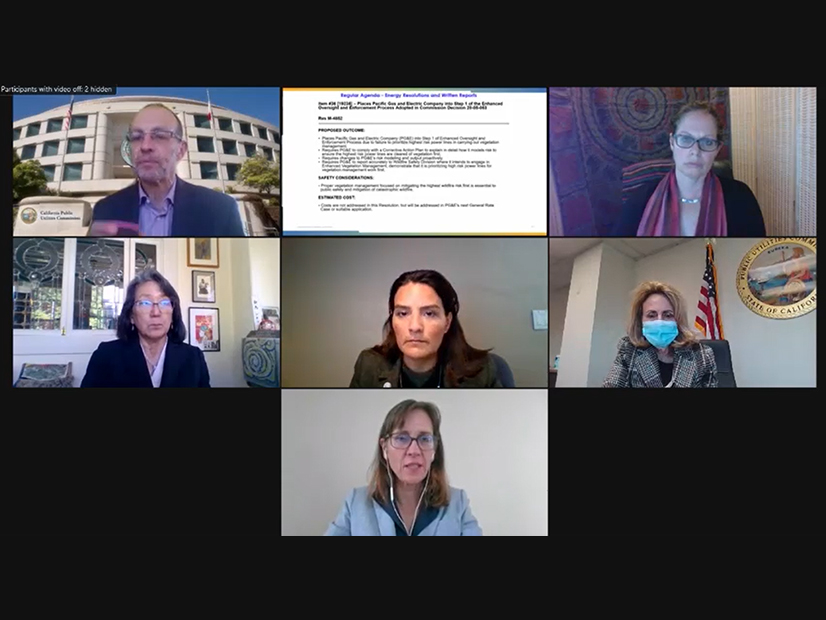The California Public Utilities Commission used its new enhanced oversight and enforcement powers for the first time Thursday against Pacific Gas and Electric, citing the utility’s failure to adequately weigh wildfire risks in maintaining its power lines.
Commissioners voted to put PG&E into the first step of a six-step enforcement process that could lead to the utility being placed into receivership or, ultimately, to the revocation of its license to operate as the state’s largest monopoly utility.
“We’ve never had a process like this for any other utility, and I don’t know of any other PUC in the country that has a process like this,” Commissioner Clifford Rechtschaffen said. “Now we shouldn’t congratulate ourselves with that. It’s a process that’s warranted given PG&E’s conduct.”
The draft resolution, approved unanimously Thursday, says PG&E “is not sufficiently prioritizing its enhanced vegetation (EVM) management based on risk.”
“PG&E ranks its power line circuits by wildfire risk, but the work performed in 2020 demonstrates that PG&E is not making risk-driven investments. PG&E is not doing the majority of EVM work — or even a significant portion of work — on the highest risk lines,” it said. “PG&E conducted more work in 2020 on lower risk power lines than high risk lines if one examines the 161 power lines on which PG&E performed EVM. Less than 5% of the EVM work PG&E completed was on the 20 highest risk power lines according to PG&E’s own risk rankings.”
PG&E agreed to the CPUC’s six-step process as part of its exit from bankruptcy in June 2020. The enhanced oversight and enforcement process was later enacted into law under a bill signed by Gov. Gavin Newsom in July. Senate Bill 350 also authorized the state to seize PG&E through eminent domain, if warranted, and transfer its operations and assets to a nonprofit public benefit corporation. (See Governor Signs PG&E ‘Plan B’ Takeover Bill.)
In November, CPUC President Marybel Batjer wrote to then-acting CEO William Smith saying the commission was considering putting PG&E into the stricter oversight regime because of the utility’s vegetation and line maintenance. (See PG&E Faces ‘Enhanced Oversight’ by CPUC.)
The warning turned to action Thursday.
Step one of the process requires PG&E to submit a corrective plan to CPUC Executive Director Rachel Peterson within 20 days. The plan must describe how the company proposes to mitigate the safety risks that triggered the enhanced oversight process. If PG&E fails to adhere to the plan, the CPUC can move to the second step of its enforcement process, which may include activities such as increased inspections, quarterly reports and spot auditing of the utility’s fire-prevention efforts.
Federal Judge William Alsup, who oversees PG&E’s criminal probation stemming from the 2010 San Bruno gas explosion, has expressed similar concerns about vegetation management and is weighing new probation conditions that could require PG&E to de-energize lines during high-risk fire conditions that have not been cleared of overhanging trees. (See Conflict over Power Shutoffs Grows in California.)
In September, a leaning pine tree struck a PG&E transmission line in rural Shasta County and started the Zogg Fire, which killed four residents and burned 56,000 acres, the California Department of Forestry and Fire Protection determined.
The state’s largest utility was also blamed for catastrophic wildfires from 2017 to 2019, caused by its equipment contacting vegetation. The blazes included the Camp Fire in November 2018, which killed 85 people and destroyed more than 14,000 homes in the town of Paradise. PG&E pleaded guilty to 84 counts of manslaughter and arson in that case.



